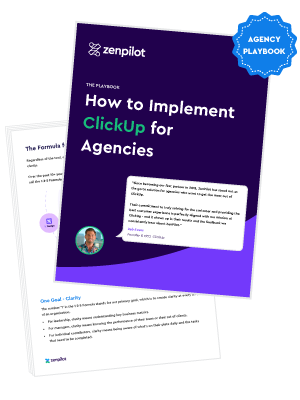Agency Project Management: 10 Steps to the Smoothest Website Project Ever
To chat with Gray and have ZenPilot lead your team through the last project management implementation you'll ever need, schedule a quick call here.
Agency project management can be quite a challenge. And of all the projects an agency can take on, it seems like websites have the biggest potential to spiral out of control.
I’ll be honest, when I first started doing website development projects, I was pretty naive about the potential of what could go wrong. I mean, “What could possibly happen?”
All too often websites take far longer than anybody expected. Without a solid process, you’ll start with one idea for a website, and by the end, will deliver something fifty shades different. If you’re not careful, website projects will wreck your profitability and burn out your team.
If You Don’t Have a Process, You’re to Blame for a Nightmare Agency Website Project
All that being said, however, it comes down to this—we shouldn’t blame our clients for a website that’s gone wrong.
If we don’t have a proven process for handling these kinds of projects then the blame is on us. You have to come to every new project with a process.
10 Baseline Steps to Help You Run the Smoothest Project Ever:
Step: 1 Deep Dive into Their Needs During the Sales Process
Before even initiating a website design and development project, you need to fully understand what the prospect is looking for.
- What is their overall goal?
- What functionality is necessary?
- What kind of primary templates? How many?
- Overall, how large is the project?
- Do they have any known issues (e.g. blacklisted by Google)?
- Does anything need migrated?
You can’t afford to slim on the details in the sales process. Dive deep and figure out what the undertaking will be. This will help your team not only decide whether the project is right, but what the price ballpark is going to look like.
Your sales team might not have as in-depth an understanding as your lead developer. Encourage your sales team to ask development to hop on the call to address any preliminary questions. They’ll also probably think of a few things that sales might would have otherwise looked over.
Step 2: Establish a Budget
Alright—so you know their needs. Now, you need to figure out what they’re willing to spend.
If they want a 200-page site—with content implemented, 20 templates, and a full-on blog migration from a different system—but are only willing to spend $1,000, then this isn’t a reasonable project to take on.
Before it goes any further, you can acknowledge that the project scope and budget aren’t in alignment. In some cases, you might be able to encourage them to raise their budget, but in others it’s time to walk away.
Throw Out the Ballpark on the First Sales Call
After figuring out what their needs are, don’t be afraid to toss out a price range. Sales will have a pretty good idea of project scope and will have a ballpark.
See how that ballpark sits with the prospect. Is it close to budget? Way, way out of budget?
Again, before things go too far, you need to figure out if they’re willing to spend what you charge.
Step 3: Finalize Details in a Contract
If you make it past Step 1 and 2 then you’re well on your way!
At this point, however, you need to solidify the exact details of the project. You’ve covered some bases early on, but you need a clear picture from start to finish.
- How is the website being handled from start to finish?
- How many revisions are allowed at each stage? What constitutes a revision?
- How many templates are being built? What are their names?
- How many pages are going to be implemented? If you’re not then specify.
- Who is providing copy? Images?
- Is any kind of SEO work included?
- Who is launching the site?
- What is the time frame you both need to complete the project within? What happens if they slow down the process?
- How are approvals handled?
Put all of these kinds of details in a clearly written contract. Once it’s written, don’t just email it over. Hop on the phone, or meet in person, to go over every line item and clause before signing on the dotted lines.
Step 4: Take a Deposit
Website projects can take a while to complete, especially depending on project size.
I recommend requiring 50% of the total cost before initiating the project. You need some revenue to keep your agency going strong. It could be another six months before you see that final invoice come through.
It’s also a good practice to help clients further commit to the work at hand.
Step 5: Gather Design Preferences, and Logins
Before you put the pen to paper, or mouse to PhotoShop for mocks, you need to have a baseline understanding of the client’s design preferences.
One way we tackled this is by putting together a Design Preferences Survey. In it, we gather their preferences on anything from site layout, to font sizes, to the way images are utilized.
This is a good gauge, but don’t ever forget the role you play in the process. You are a valued, strategic partner. Although your clients might not always agree with you, they’ll respect if you discuss best practices. If there’s something that will be better for the overall project, discuss it and always talk about the why associate with it.
Get Logins Right Away
Another item to gather on the front end, is all of the logins you’ll need. These are to their domain and host managers.
Sometimes this kind of information can take a while to get approved by management. Once approved, it can take some time for IT to grant you access, so get your request in early.
You don’t want to be on the night of launching a site without these credentials.
Get the step-by-step onboarding process used by thousands of agencies. Download Now
Step 6: Kick off with Mock Ups
There’s nothing worse than doing development work and having the client tear it to shreds.
Presenting a mock-up—built in PhotoShop—for feedback takes less time and resources than a live rendering. Always, always, always start with mock-ups.
You’ll be able to get a clear visual direction before one single line of code is written.
Mock Ups Are What They Can Expect
Another great element of mock-ups, is the client will know what they’re going to get. This will shrink the likelihood that they’ll see the site and try to get you to change major elements.
One of the biggest dangers of website projects is that clients often want to make a lot of changes. These changes often go beyond the revisions included and can spiral out of control.
I like to make it clear that if they approve the mock ups, that’s what they’re going to get (with two minor rounds of revisions on the final product).
Step 7: Prepare a Site Architecture to Present the Lay of the Land
A site architecture is an in-depth spreadsheet with every page laid out.
This will help you understand how the site needs to be built out. It will also help the clients figure out what to consolidate, subtract, or add.
We talk a lot about the ability to agencies to master “concurrent” task management. This is one you can have going on side-by-side with the mock up phase to move the project forward faster.
Step 8: Launch the Project and Several Simultaneous Objectives at Once
I touched on this a bit just a moment ago, but you need to be able to handle multiple tasks at one time.
When managing a website project, think in terms of “What can we do concurrent?”
An example would be running mock ups, site architecture, and SEO research at the same time.
Step 9: Maintain Consistent Communication
Website projects often fall off the rails because project managers don’t communicate progress. Make it a habit to communicate the big updates for clients.
If you’re going to run into a snag then communicate it. If the client is delaying the project then communicate it.
Step 10: Present an Approval/Launch Sign Off Agreement Before Launching
One of the biggest questions marks you’ll run into is, “What actually fulfills this contract and what happens after the site is launched?”
You can prevent scope creep and requests for unpaid edits after the site launch with one simple move—an approval/launch sign-off agreement.
What This Does
The approval/launch sign-off agreement states that the client acknowledges that work is complete, things are functioning as they should, and the terms of what happens if additional work is requested.
Structure Wins Battles
By coming into every website project—no matter how big or small—you’ll be better leading your clients to reaching their goals. You’ll also be best leading your agency to becoming scalable, efficient places to work.




